I was intrigued to find this passage in the R. T. Holman entry in the Dictionary of Canadian Biography earlier this week:
R. T. Holman was a merchant who stood apart from the social life of his small community, who apparently neither sought nor gained political favours, and who possessed unorthodox religious beliefs. Though Holman had been born into a Baptist family, his father had left the church in 1835 following a doctrinal disagreement with a clergyman. It is not evident how Robert’s views on religion developed, but the census of 1861 listed him as a “universalist” and by the 1870s he had abandoned organized religion in favour of free thought. Not content to object passively to the predominant religious sentiment of the community, he brought speakers to Summerside to preach humanism. One example of his antipathy was his response to the province’s proclamation of Thanksgiving in 1899. He protested in a half-page advertisement in the Pioneer that the day should be “free from cant, free from hypocracy and free from policy” and that consequently his stores would remain open.
Prince Edward Island is a challenging place to be weird, and so it’s useful to look to history for examples of successful weird people like Holman.
The ad that’s referenced is an interesting one. Here’s the version that ran on October 18, 1899 – the day before Thanksgiving – in the Summerside Journal:
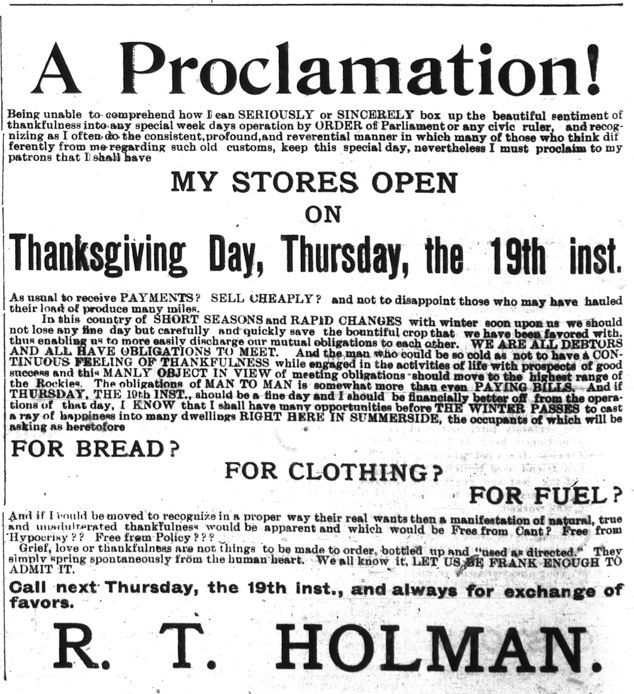
It reads:
A Proclamation!
Being unable to comprehend how I can SERIOUSLY or SINCERELY box up the beautiful sentiment of thankfulness into any special week days operation by ORDER of Parliament or any civic ruler, and recognizing as I often do the consistent, profound, and reverential manner in which many of those who think differently from me regarding such old customs, keep this special day, nevertheless I must proclaim to my patrons that I shall have
MY STORES OPEN
ON
Thanksgiving Day, Thursday, the 19th inst.
As usual to receive PAYMENTS? SELL CHEAPLY? and not to disappoint those who may have hauled their load of produce many miles.
In this country of SHORT SEASONS and RAPID CHANGES with winter soon upon us we should not lose any fine day but carefully and quickly save the bountiful crop that we have been favored with, thus enabling us to more easily discharge our mutual obligations to each other. WE ARE ALL DEBTORS AND ALL HAVE OBLIGATIONS TO MEET. And the man who could be so cold as not to have a CONTINUOUS FEELING OF THANKFULNESS while engaged in the activities of life with prospects of good success and this MANLY OBJECT IN VIEW is somewhat more than even PAYING BILLS. And if THURSDAY, THE 19th INST., should be a fine day and I should be financially better off from the operations of the day, I KNOW that I shall have many opportunities before THE WINTER PASSES to cast a ray of happiness into many dwellings RIGHT HERE IN SUMMERSIDE, the occupants of which will be asking heretofore
FOR BREAD? FOR CLOTHING? FOR FUEL?
And if I could be moved to recognize in a proper way their real wants then a manifestation of natural, true and unadulterated thankfulness would be apparent and which would be Free from Cant? Free from Hypocrisy?? Free from Policy???
Grief, love or thankfulness are not things to be made to order, bottled up and “used as directed.” They simply spring spontaneously from the human heart. We all know it, LET US BE FRANK ENOUGH TO ADMIT IT.
Call next Thursday, the 19th inst., and always for exchange of favors.
R. T. HOLMAN
Oliver’s MacBook Air power supply had become dangerously frayed, to the point where continued use would have involve low-level electrocution. Sugru to the rescue, and some personalization thrown in for effect (in 14 pt. Bodoni):
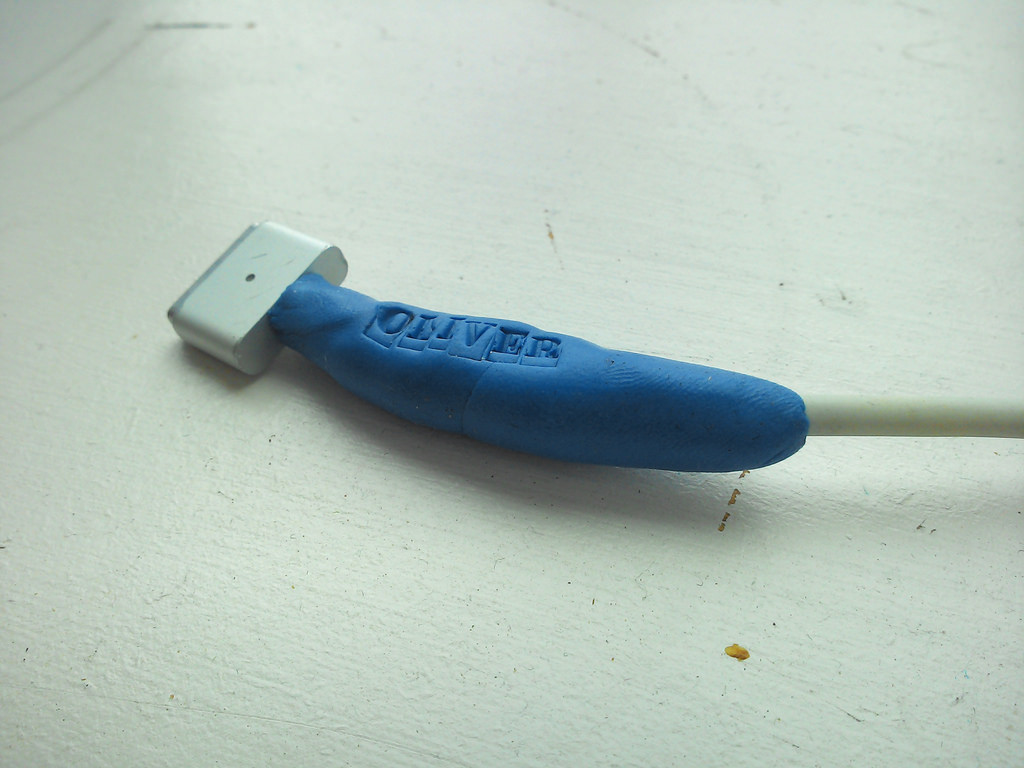
Usually I’m at the other end of the camera, so there are very few photos of me when I’m traveling.
Which is why this photo of Oliver and me in Berlin, along with Sam Stewart and Matthew Richard, taken in 2010, is such a nice thing to stumble across.
We all happened to be in Berlin the same week, and we met up at Yellow Sunshine on Weiner Straße one night for burgers and debrief.
I was reminded of that night this afternoon when I encountered Matthew behind the counter at The Kettle Black, where he’s working for the summer (and where he’s making fantastic coffee, having honed his skills, I am told, in the big city).
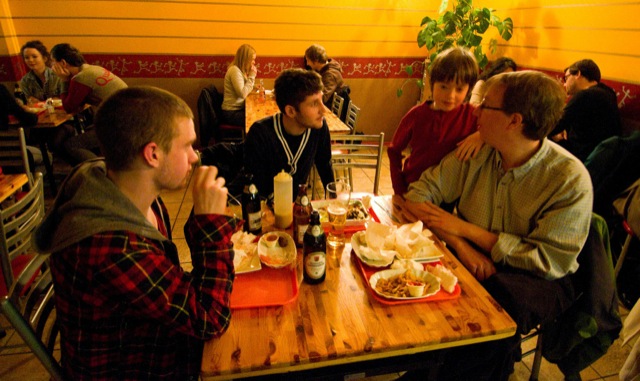
We were all so young then.
One of the confounding aspects of our two weeks spent in a VW camper in Europe this summer was that I struggled to keep my mobile phone charged from the camper’s electric outlets.
The design of the camper’s electrical system didn’t help: there are two power outlets behind the driver’s seat: one works while the camper is on the road, the other when it’s parked and plugged into the mains. Meaning that I had to switch back and forth at least twice a day, and, what’s more, to remember which was which.
But still, the phone would often end up dead in the middle of the day, for reasons I couldn’t explain, and I became convinced that the VW electrical system was flaky.
It never occured to me that the micro USB cable I was using to charge the phone would be at fault. But it was.
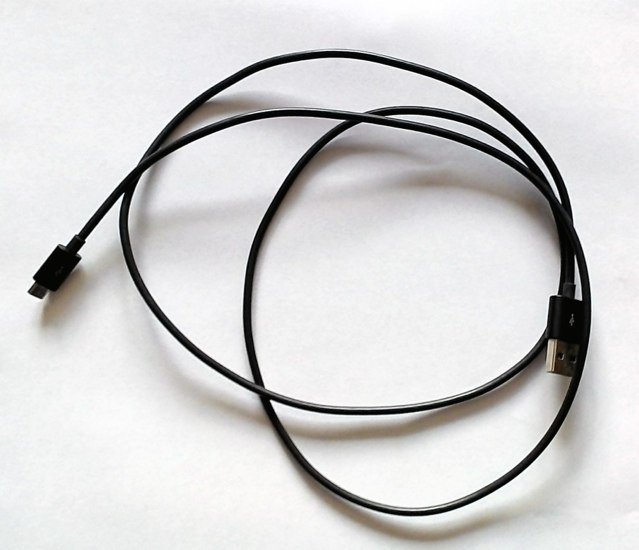
Returning home to the Reinventorium I found, sure enough, that this cable, the one that came with the phone, one worked if it was plugged in “just so,” and exactly what that meant changed every day.
Why I opted to believe that a brand new $60,000 vehicle was at fault when it was, in truth, a $2.00 cable, is beyond me.
Speaking of which: what’s up with the price of micro USB cables in retail stores? I went over to The Source in the Confederation Court Mall to buy a replacement for this faulty cable and all they could sell me was this $24.99 Blackberry-branded cable. I finally found one for “only” $14.99 up at Target. But still, when Monoprice retails these cables for $1.11 it makes the local pricing, even if you factor the acceptable cost of “I just had to walk a block instead of waiting a week,” seems like highway robbery.
For $93 I could buy 100 micro USB cables from Monoprice and just pass them out on the street as a public service. Hey, maybe I should do that.
The answer to the question “where to put the second wire hanging system to mount even more of my collected paper works” appeared today, on the opposite wall:
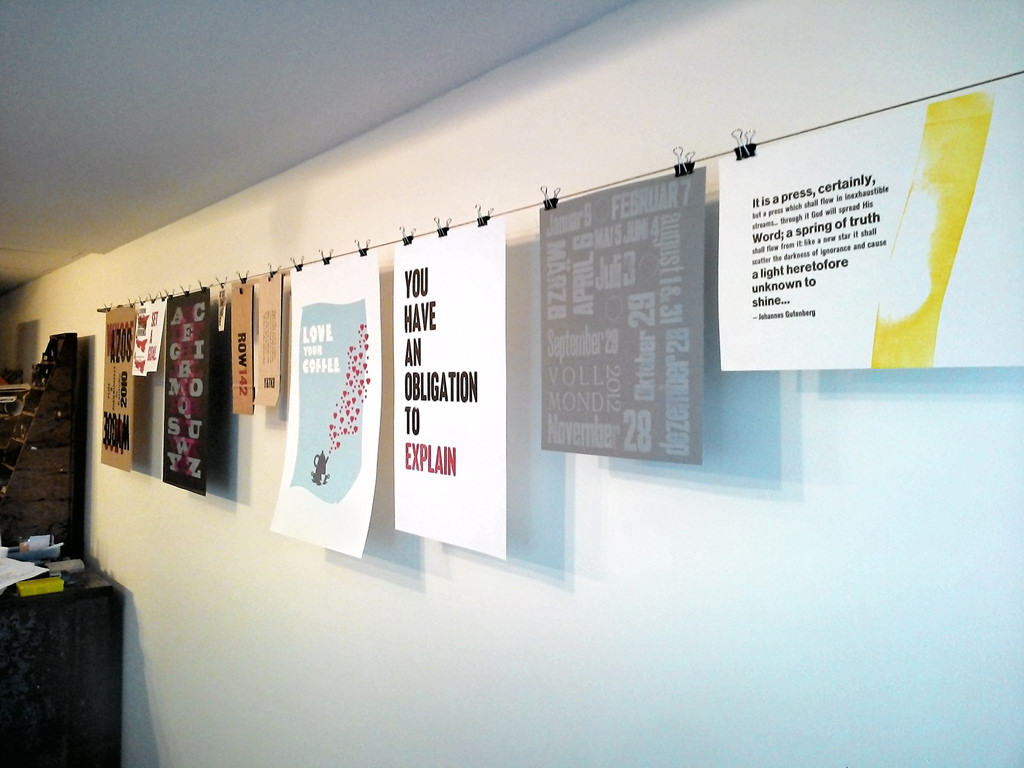
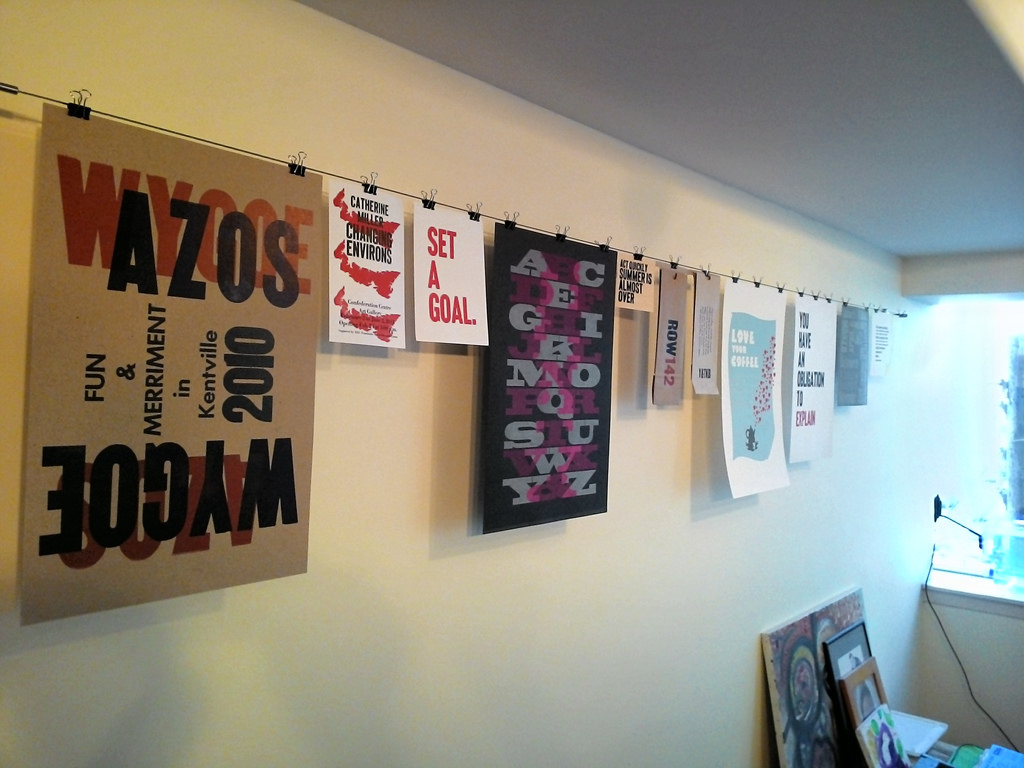
A few more items from the Gaspereau Wayzgoose along with a few more of my own items, including, from the right to left, the piece I printed in Mainz at the Gutenberg Museum, the Moon calendar I printed in 2011 in Berlin, and the You Have An Obligation to Explain I printed in the summer of 2012. And, of course, coffee bags.
I’ve again taken the official Prince Edward Island School Calendar and updated a set of public calendar files to make it easier for parents and others to shunt the information around their digital devices. Here you go:
(Note for those of you who already had the 2013-2014 School Calendar integrated into your digital devices: you don’t need to do anything, as those addresses haven’t changed from last year).
As a member of the School Calendar Committee for the PEI Home and School Federation I again asked to have the official calendar released as structured data by the Department of Education and Early Childhood Development itself, but as yet this (still) hasn’t happened.
Back last year, when my friends Luisa and Olle put their Malmö apartment up for sale, they had some lovely photos taken by their real estate agent, including this one of the wall in their living room, a photo that, as it happened, featured a number of the pieces of printing I’d sent them over the years:

I closely associate such a wall-of-ephemera with Olle and Luisa, and I’ve always been jealous of their sophisticated Scandanavian hanging system that makes it possible.
I tried my hand at something similar in the old Reinvented HQ on Fitzroy Street using 3M damage free hooks and a roll of twine, but I was never satisified, neither with the tautness nor with the fact that it eventually all came tumbling down.
This summer, with a collection of my own printed ephemera growing by the month, I resolved to find a solution and, after banging away in Google with search phrases like “wire rope hanging system,” I found my way to Ikea’s Digniet curtain wire, which seemed like exactly the Scandanavian hanging system I was looking for. I ordered three sets – if I was going to solve this problem, I was going to solve it everywhere – and they arrived a few weeks ago.
Tonight I finally managed to assemble the screws and anchors (not included by Ikea), electric drill and level, and, along with a handy installation guide from a woman in California and I set to work. Thirty minutes later, this is where I’ve ended up:
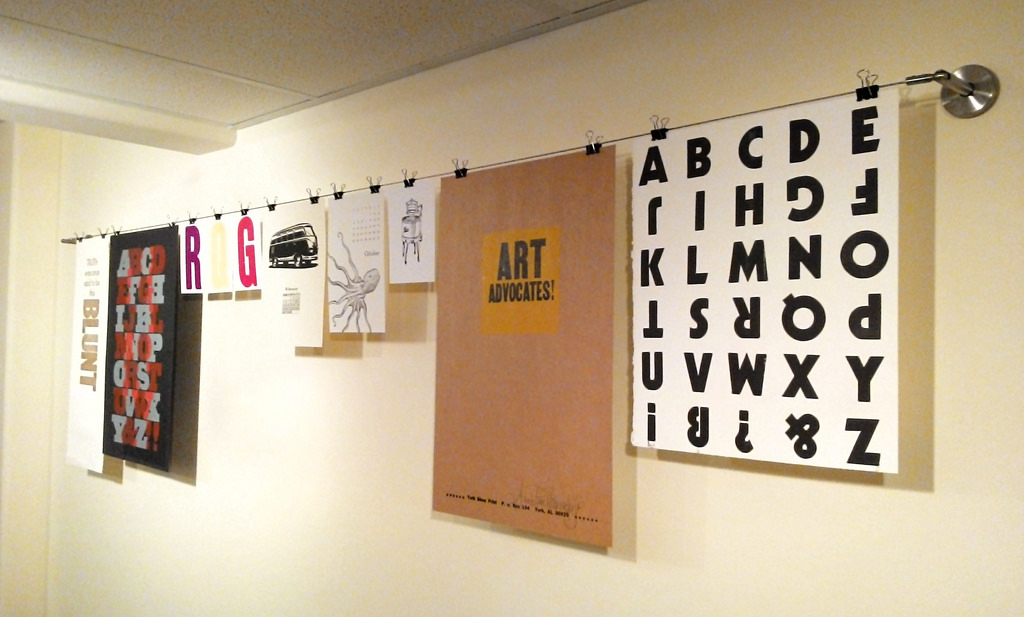
The work is mostly by others, the exception being the alphabet book on the far-right, which is perhaps my favourite of all the things I’ve printed, and the Thor washing machine two spots to the left (from a letterpress engraving loaned to me by Ian Scott), which I’ve always liked. Otherwise there are a few pieces from the Gaspereau Wayzgoose, some colourful letters from Drukkerijmuseum Meppel and a few of my favourite calendar pages from the letterpress calendars I’ve collected over the years.
The Digniet curtain wire system’s instructions are a little complicated to parse, being delivered in traditional “why use words when complex illustrations will do?” Ikea fashion:

The news about the screws and anchors not being included is the only information delivered with words – in 29 languages, no less! The customer is advised “for advice on suitable screw-systems, contact your local specialised dealer,” wording that makes me perhaps thankful that they opted for the illustrations rather than the words for the rest of the story.
Once I parsed the instructions – something aided greatly by the advice from California – it all turned out to be rather ingenious and very satisfyingly taut when tightened. I’m very happy with the result.
Now, to find a place for the other two…
Since launching a few years ago, IslandNewspapers.ca would have been more accurately named without the final “s,” as The Guardian was the only newspaper you’d find there.
That all changed this week with the introduction of Haszard’s Gazette – “Farmer’s Journal and Commercial Advertiser” – covering the years from 1851 to 1857, a period that predates The Guardian by almost 40 years.
Here’s how it’s described there:
Haszard’s Gazette was established by James D. Haszard in 1851. Haszard had previously been the Queen’s Printer, and, on being displaced from this office by Edward Whelan, he immediately began the publication of his own paper, Haszard’s Gazette. He published it himself until 1853, when he retired in favour of his son, George T. Haszard. Several other publishers and editors followed. Haszard’s Gazette printed some foreign and local news, fiction, anecdotes and advertisements. It was largely nonpolitical, but its viewpoint did vary under its different editors Reform, biblical instruction in the schools and temperance were all discussed in Haszard’s Gazette. In March of 1857, Haszard’s Gazette was merged with the Protector and Christian Witness.
It’s a welcome addition to the almost 70 years of The Guardian now digitized and searchable, and I encourage you to take it out for a ride.





If I was writing my list of best things on Prince Edward Island, somewhere near the top would have to be the Factory Coffee from Island Chocolates in Victoria.
It’s a chocolate-lined glass filled with coffee and topped with whipped cream. And it’s pure heaven: I literally have dreams about it.
I’ve cut way, way back on sugar over the past 2 years, to the point where the amount of chocolate I consume in a year would fit in the palm of one hand. The Factory Coffee is one of the few things I make an exception for.
Do yourself a favour: some day this summer head out to Victoria, order yourself one, find a seat on the front porch, and drink it slowly.

So not only was R.P. Haythorne Prince Edward Island’s Premier-that-time-forgot, but he was also involved in the hunt for the last bear in Marshfield, as he reported in The Examiner on July 27, 1863 (a letter that appears in the excellent Marshfield and area: A Grand Legacy:
To the Editor of the Examiner.
Sir:—Rumors of a Bear being amongst us have been current for some time past, which received tangible confirmation by the slaughter of certain sheep and lambs on the farms of Mr. Alexander Stewart and others. Being disturbed in that direction, Bruin shifted his quarters to the farm of R. P. Haythorne, Esqr., where on Thursday night last, he destroyed five sheep and a lamb. Measures were immediately adopted for a general hunt; and on the same afternoon between thirty and forty persons, resident in the neighborhood, met at St. Cuthbert’s Mills for that purpose.
The hunt was joined by His Excellency the Lieutenant Governor and Mr. Atkinson, and by several gentlemen from Charlottetown. After a long and tedious search, the bear was at length started [sic] on the western side of Gough’s Creek, and fired at without success. He re-crossed the creek and in an incredibly short space of time had crossed the St. Peter’s Road, in the vicinity of the Marshfield School House, where he was headed by Mr. Alexander Robertson and his sons and some others. The fatal shot was fired near the schoolhouse by Mr. James Wyatt. The animal proved to be a full grown male, of enormous dimensions, and was estimated by experienced judges to weigh not less than 300 lbs. The skin, it was unanimously voted by the assembled hunters, should be presented to His Excellency.
Your obedient servant,
R. P. HAYTHORNE. 1863.
I am happy to report that since my missive lamenting the lack of recognition for Premier Haythorne in this year of Confederation memorializing that word has come in from Marshfield that there is, in fact, an event planned:
A display board will be established to preset the details of the life of Premier Robert Poore Haythorne on the site of his Haythorne family home. Premier Haythorne’s provincial government negotiated the terms under which PEI would enter Canadian confederation with the Canadian government of Sir John A. MacDonald. A community celebration will occur at the unveiling.
I can think of no better kickoff for the drive to rename a significant Island building after Haythorne, and invite all Haythornites to make an effect to attend this event.
 I am
I am